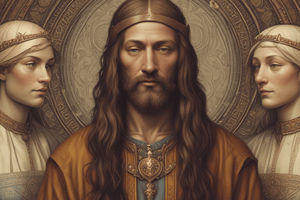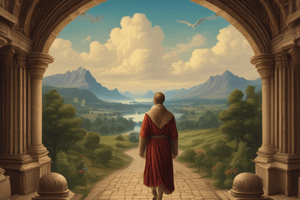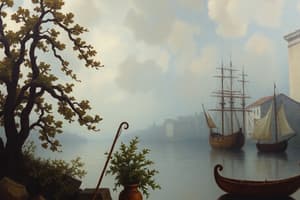Podcast
Questions and Answers
Which of the following best describes humanism during the Renaissance?
Which of the following best describes humanism during the Renaissance?
- A renewed interest in classical art forms.
- An emphasis on scientific experimentation and observation.
- A philosophical movement emphasizing human value and agency. (correct)
- A focus on theological studies and religious dogma.
The Renaissance began in France during the 15th century.
The Renaissance began in France during the 15th century.
False (B)
Which of these was NOT a technique used by Renaissance artists to enhance realism?
Which of these was NOT a technique used by Renaissance artists to enhance realism?
- Pointillism (correct)
- Perspective
- Chiaroscuro
- Sfumato
The invention of the ______ significantly contributed to the spread of knowledge during the Renaissance.
The invention of the ______ significantly contributed to the spread of knowledge during the Renaissance.
Which scientist made significant contributions to astronomy and physics during the Renaissance?
Which scientist made significant contributions to astronomy and physics during the Renaissance?
Renaissance literature was characterized by a renewed interest in classical forms and the vernacular.
Renaissance literature was characterized by a renewed interest in classical forms and the vernacular.
Which of the following was a key factor in the emergence of the Italian Renaissance?
Which of the following was a key factor in the emergence of the Italian Renaissance?
Name one artistic technique that emerged during the Italian Renaissance.
Name one artistic technique that emerged during the Italian Renaissance.
Match the artist with their famous work:
Match the artist with their famous work:
Which of the following is a key characteristic that distinguishes the Northern Renaissance from the Italian Renaissance?
Which of the following is a key characteristic that distinguishes the Northern Renaissance from the Italian Renaissance?
Name one artist associated with the Northern Renaissance.
Name one artist associated with the Northern Renaissance.
Which invention by Johannes Gutenberg revolutionized the dissemination of knowledge during the Renaissance?
Which invention by Johannes Gutenberg revolutionized the dissemination of knowledge during the Renaissance?
The establishment of bureaucracies was a characteristic of the 'New Monarchies' during the period from 1450 to 1648.
The establishment of bureaucracies was a characteristic of the 'New Monarchies' during the period from 1450 to 1648.
Which of the following factors contributed to the emergence of 'New Monarchies' in Europe?
Which of the following factors contributed to the emergence of 'New Monarchies' in Europe?
Name one characteristic of the 'New Monarchies'.
Name one characteristic of the 'New Monarchies'.
Which of the following explorers is credited with the first circumnavigation of the globe?
Which of the following explorers is credited with the first circumnavigation of the globe?
The exchange of plants, animals, and diseases between the Old World and the New World following Columbus's arrival is known as the ______.
The exchange of plants, animals, and diseases between the Old World and the New World following Columbus's arrival is known as the ______.
During the Age of Exploration, what was a primary motive for European countries to seek new trade routes to Asia?
During the Age of Exploration, what was a primary motive for European countries to seek new trade routes to Asia?
The Commercial Revolution led to a decrease in prices due to the abundance of goods from Asia, Africa, and the Americas.
The Commercial Revolution led to a decrease in prices due to the abundance of goods from Asia, Africa, and the Americas.
Which European power established colonies primarily in Brazil and the Atlantic islands, initiating the large-scale transatlantic slave trade in the 15th century?
Which European power established colonies primarily in Brazil and the Atlantic islands, initiating the large-scale transatlantic slave trade in the 15th century?
Flashcards
The Renaissance
The Renaissance
A cultural and intellectual rebirth in Europe, starting in Italy in the 14th century, marked by renewed interest in classical learning, humanism, and the arts.
Humanism
Humanism
A philosophical movement emphasizing the value and agency of human beings, individually and collectively.
Renaissance Art Techniques
Renaissance Art Techniques
Using techniques like perspective, chiaroscuro, and sfumato to add depth and realism to paintings.
Scientific Method in Renaissance
Scientific Method in Renaissance
Signup and view all the flashcards
European Society at the Time
European Society at the Time
Signup and view all the flashcards
Causes of Exploration
Causes of Exploration
Signup and view all the flashcards
Italian Renaissance
Italian Renaissance
Signup and view all the flashcards
Emergence of Italian Renaissance
Emergence of Italian Renaissance
Signup and view all the flashcards
Northern Renaissance
Northern Renaissance
Signup and view all the flashcards
Key Aspects of Northern Renaissance
Key Aspects of Northern Renaissance
Signup and view all the flashcards
Printing Press
Printing Press
Signup and view all the flashcards
New Monarchies (1450-1648)
New Monarchies (1450-1648)
Signup and view all the flashcards
Factors for monarchies emergence
Factors for monarchies emergence
Signup and view all the flashcards
Characteristics of New Monarchies
Characteristics of New Monarchies
Signup and view all the flashcards
Age of Exploration
Age of Exploration
Signup and view all the flashcards
Causes of Exploration
Causes of Exploration
Signup and view all the flashcards
Major Explorers
Major Explorers
Signup and view all the flashcards
Commercial Revolution
Commercial Revolution
Signup and view all the flashcards
Economic Effects of Revolution
Economic Effects of Revolution
Signup and view all the flashcards
Columbian Exchange
Columbian Exchange
Signup and view all the flashcards
Study Notes
Context of the Renaissance
- A cultural and intellectual rebirth started in 14th-century Italy and spread through Europe until the 17th century.
- Key characteristics included a renewed interest in classical learning, humanism, and the arts.
Humanism
- A philosophical and intellectual movement emphasizing the value and agency of human beings
- It promoted individualism and collectivism.
- A reaction to scholasticism of the Middle Ages, which focused on theology and philosophy
- It valued education, reason, critical thinking, classical literature, history, and art.
Renaissance Art
- Characterized by renewed interest in classical forms, realism, and humanism
- Artists like Leonardo da Vinci, Michelangelo, and Raphael emphasized the beauty and complexity of human form in their works.
- Techniques like perspective, chiaroscuro, and sfumato were used to create depth and realism in paintings.
- Printing technology enabled widespread dissemination of art and ideas.
Renaissance Science
- A period of scientific discovery and innovation
- Scientists like Galileo Galilei and Johannes Kepler contributed to astronomy and physics.
- The scientific method, emphasizing observation, experimentation, and empirical evidence, transformed natural world understanding.
Renaissance Literature
- Characterized by renewed interest in classical forms, humanism, and the vernacular
- Writers like William Shakespeare, Miguel de Cervantes, and Dante Alighieri explored human nature, morality, and the human condition.
- The printing press facilitated the spread of literature across Europe, disseminating ideas and knowledge.
European Society
- It experienced artistic and cultural flourishing.
- Saw scientific advancements and discoveries
- There was a rise of nation-states and centralized power.
- Experienced the Protestant Reformation and religious conflicts
- Exploration and colonization of the New World occurred
- Emergence of the middle class and capitalism was present
- Patriarchal society limited women's rights.
- Slavery and exploitation of non-European peoples was common.
- Plague outbreaks and public health were concerns.
Beginning of Exploration
- Crusades resulted in a desire for new trade routes to Asia
- Focus on Renaissance, and the revival of classical knowledge
- Technological advancements in navigation and shipbuilding were key
- Competition existed between European nations for wealth and power.
- Columbus' discovery of the New World
Italian Renaissance
- A period of great cultural and artistic growth in Italy, lasting from the 14th to the 17th century
- Characterized by renewed interest in classical art, literature, philosophy, humanism, and individualism
Emergence of the Italian Renaissance
- Factors included rediscovery of ancient Greek and Roman texts, growth of wealthy merchant classes, and patronage of wealthy families like the Medici
- These factors led to a flourishing of the arts, sciences, and humanities, and a renewed interest in humanism and individualism.
Impact of the Italian Renaissance
- Profoundly influenced Western culture through art, literature, philosophy, and science.
- Led to new artistic techniques like perspective and chiaroscuro
- Inspired artists like Leonardo da Vinci, Michelangelo, and Raphael
- Influenced Italian language and literature through the works of Dante, Petrarch, and Boccaccio
Famous Works of the Italian Renaissance
- Leonardo da Vinci's "Mona Lisa" and "The Last Supper"
- Michelangelo's "David" and the ceiling of the Sistine Chapel
- Raphael's "The School of Athens" and "The Sistine Madonna"
- Dante's "Divine Comedy"
- Petrarch's sonnets and other poetry
- Boccaccio's "The Decameron"
The Northern Renaissance
- A cultural and artistic movement in Northern Europe during the 15th and 16th centuries
- Characterized by a renewed interest in classical learning and a focus on individualism and humanism
Key Characteristics
- Humanism: renewed interest in classical learning and humanism, emphasizing individualism, reason, and classical studies.
- Religious Reformation: marked by the Protestant Reformation, challenging the Catholic Church's authority and leading to new Protestant churches.
- Artistic Innovation: Artists experimented with new techniques and styles.
- Emphasis on realism, detail, and the use of light and shadow.
- Scientific Advancements: Significant contributions to astronomy, mathematics, and anatomy.
Key Figures of the Northern Renaissance
- Albrecht Dürer: German artist known for engravings and woodcuts with religious and mythological themes.
- Jan van Eyck: Flemish painter known for oil paint use and detail. The Ghent Altarpiece is his most famous work.
- Desiderius Erasmus: Dutch humanist and scholar known for his critical approach to religion and belief in education.
- William Shakespeare: English playwright and poet regarded as one of the greatest writers.
Printing Press
- Invented by Johannes Gutenberg in the mid-15th century
- Revolutionized information dissemination during the Renaissance
- Prior to the printing press, books were expensive and rare because they were copied by hand.
- Allowed books to be produced quickly and cheaply, leading to widespread distribution of knowledge and ideas
- Increased literacy rates and the spread of new ideas
Important Books Disseminated Through the Printing Press
- The Bible: Promoted Christianity and religious reform
- Works of William Shakespeare: Made him one of the most widely read English writers.
- Works of Galileo Galilei: Challenged views of the universe and ushered in the Scientific Revolution
- Works of Martin Luther: Played a key role in the Protestant Reformation.
- Works of Johannes Gutenberg: Helped promote the spread of printing technology.
New Monarchies
- Refers to the period of European history from 1450 to 1648
- Monarchies underwent significant changes in political, economic, and social structures.
- Powerful monarchies emerged, centralizing power and establishing strong states.
- New monarchies were characterized by consolidation of power, establishment of bureaucracies, expansion of armies, and growth of national economies.
Contributing Factors to the Emergence of New Monarchies
- Decline of Feudalism: Led to new social and economic classes.
- Growth of Trade and Commerce: Gave rise to wealthy merchants and bankers.
- Renaissance: Resulted in new ideas about government and society.
- Religious Reformation: Led to new religious and political ideologies challenging the Catholic Church.
Characteristics of New Monarchies
- Centralization of Power: Monarchs became the ultimate authority.
- Establishment of Bureaucracies: They managed state affairs efficiently.
- Expansion of Armies: For power maintenance and territory protection.
- Growth of National Economies: Promoted through trade, commerce, and policies.
Examples of New Monarchies
- France
- King Louis XI (1461-1483) strengthened the monarchy through centralization.
- King Francis I (1515-1547) created a standing army and established the Concordat of Bologna.
- King Henry IV (1589-1610) ended the Wars of Religion and established the Bourbon dynasty.
- Spain
- Queen Isabella I (1474-1504) and King Ferdinand II (1479-1516) united Spain through marriage and conquest.
- King Charles I (1516-1556) inherited the Spanish throne and became Holy Roman Emperor.
- England
- King Henry VII (1485-1509) established the Tudor dynasty.
- King Henry VIII (1509-1547) broke with the Catholic Church.
- Queen Elizabeth I (1558-1603) defeated the Spanish Armada and established England as a major naval power.
- Russia
- Ivan III (1462-1505) united Russia and established the Grand Principality of Moscow.
- Ivan IV (1533-1584) centralized power by creating a professional army and introducing a new legal code.
- Portugal
- King John II (1481-1495) established a strong central government and expanded Portugal's overseas empire.
Age of Exploration
- Also known as the Age of Discovery
- A period of European exploration and discovery that lasted from the 15th to the 17th century
- European explorers searched for new trade routes, resources, and territories.
Causes of Exploration
- Trade: European countries wanted new routes to Asia due to Ottoman control over traditional routes.
- Religion: They wanted to spread Christianity to new territories.
- Technology: Advances in shipbuilding, navigation, and cartography enabled long-distance travel.
- Wealth: They sought new sources of wealth like gold and silver
Major Explorers
- Christopher Columbus: Discovered the New World for Spain in 1492.
- Vasco da Gama: Sailed around the southern tip of Africa to reach India in 1498.
- Ferdinand Magellan: Led the first circumnavigation of the globe from 1519-1522.
- Francis Drake: Circumnavigated the globe and raided Spanish ships and settlements in the late 16th century.
Consequences of Exploration
- Colonization: Led to the spread of European culture and influence in the Americas, Africa, and Asia.
- Global Trade: Led to the rise of global trade and capitalism
- Cultural Exchange: Exchange of ideas, goods, and technologies led to cultural diffusion and the spread of knowledge
- Exploitation and Slavery: Colonization led to the exploitation and enslavement of native populations, particularly in the Americas and Africa.
Colonial Rivals
- European expansion is the period when European powers expanded influence and control.
- Expansion had significant effects on both colonized regions and Europe.
- Conflicts and rivalries arose from competition for resources, territory, and power.
Effects of European Expansion
- Colonial regions experienced changed culture and traditions, displacement, and enslavement.
- European powers introduced new technologies, religions, and political systems.
- Resource exploitation, like gold and silver, led to European economic growth.
- Expansion of trade and commerce helped in European economies.
Conflicts and Rivalries
- Competition among European powers led to conflicts over resources and territory
- Treaty of Tordesillas in 1494 was a result of rivalry between Spain and Portugal
- The French and Indian War came from rivalry of England and France
- The Scramble for Africa resulted from competition between European powers.
- Rivalry also contributed to the outbreak of World War I.
Columbian Exchange
- Refers to the exchange of plants, animals, and diseases between the Old World (Europe, Africa, and Asia) and the New World (the Americas) after 1492.
Impact of Columbian Exchange in Old World
- New crops increased population growth and improved diets.
- New sources of precious metals increased wealth and power.
- New diseases, like smallpox, devastated Native American populations.
Impact of Columbian Exchange in New World
- New animals transformed societies and allowed more efficient agriculture
- New technologies such as guns and iron tools, gave Europeans a military advantage
- New diseases decreased Native populations.
Slave Trade and Triangular Trade
- Began in the 15th century with Portuguese traders importing slaves from Africa for sugar plantations in the Atlantic islands and Brazil
- Grew as sugar plantations expanded in the Americas
- Triangular trade involved Europe, Africa, and the Americas
- Europe traded manufactured goods for slaves in Africa
- Slaves were transported to the Americas
- Profits from crops bought raw materials shipped back to Europe
- Abolished in the 19th century
- Legacy of racism and inequality continues to impact societies
Commercial Revolution
- A period of European economic expansion, colonialism, and mercantilism from the 16th to the 18th century.
- Resulted in significant changes in the European economy and society.
Economic Effects of the Commercial Revolution
- Growth of Trade: Linked Europe with Asia, Africa, and the Americas, facilitating the exchange of goods and ideas.
- Rise of Capitalism: Merchants and traders invested profits, leading to the growth of industries and job creation.
- Development of Banking: Banks provided loans to merchants and traders.
- Emergence of Joint-Stock Companies: Allowed investors to share risks and profits.
- Increase in Prices: Increased demand led to inflation.
Social Effects of the Commercial Revolution
- Growth of Urbanization: The growth of industries and trade led to the growth of cities
- Rise of the Middle Class: Merchants, traders, and bankers became wealthy and influential.
- Development of Consumer Culture: Increased availability of goods led to a culture of consumption.
- Expansion of Colonialism: Resulted in the exploitation of resources and enslavement of people.
Causation in the Renaissance and Age of Discovery
- Both driven by a desire for knowledge, wealth, and power.
- The Renaissance provided the groundwork for scientific innovations of the Age of Discovery.
- Technological advancements enabled the Age of Discovery
- The Age of Discovery helped the arts and sciences due to the new wealth
- Both shaped by political, economic, and social forces, including the rise of nation-states, capitalism, and new social classes.
Studying That Suits You
Use AI to generate personalized quizzes and flashcards to suit your learning preferences.




